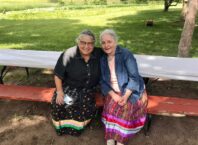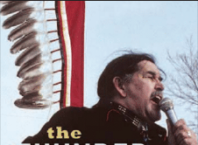It is well known that in the aftermath of the U.S.-Dakota War of 1862 when the Dakota people were being rounded up and confined at Fort Snelling, some chiefs fled with their bands into the Dakota Territory and Canada. And in most history books, that’s where the story ends – at the Canadian border.
But the often-overlooked story about what happened on the other side of the 49th parallel deserves telling, for it comes with ancient silver medals and an amazing account of refugee status based on oaths of perpetual obligation made to the Dakota people a half century before. As Minnesotans commemorate the 150th anniversary of the U.S.-Dakota War of 1862, it took a visit to the Manitoba Museum in Winnipeg, Manitoba Canada to spotlight this little-known chapter of Dakota history.
The sign in the museum’s Grassland Gallery exhibit area simply states: "Following the Sioux Uprising in Minnesota in 1862, many Dakota families moved north into British territory. In recognition of their longstanding allegiance to the British Crown, they were granted reserve lands beginning in 1874, although they did not sign treaties. By the mid-1870s, there were over 1,000 Dakota living in camps near Portage la Prairie, along the Assiniboine River, at Oak Leaf and near Fort Ellice."
What! Canadian Dakotas. Allegiance to the British Crown! How did all this happen?
The Dakota people have had a long history of crisscrossing the border and had at various times since 1821 established trading relationships with the Hudson Bay Company (HBC) at Fort Garry. Fort Garry was not a military post, but a fur trading post near the confluence of the Red and Assiniboine rivers, where Winnipeg, Manitoba, is located today.
However, this time the arrival of the Dakota at the fort was different. In the aftermath of the U.S.-Dakota War of 1862, the Dakotas came to Forth Garry as refugees, not trading partners, and they arrived with silver medals that displayed the image of King George III and claims to sanctuary based on promises made to their forefathers for their allegiance and service to the British during the War of 1812.
"The British told his people whenever they should get into trouble with the Americans, they only had to come, and the folds of the red flag of the North would wrap around them round, and preserve them from their enemies," proclaimed Little Crow on May 29, 1863, to HBC-appointed Governor Alexander Dallas.
Various historical reports and memoirs give a variety of dates, leadership names, and number of Dakotas who sought refugee at Fort Garry, but it is generally reported that the first delegation of Dakotas crossed the border to reach Fort Garry in December 1862. The 80 men and four women, who represented the 600 people who were camped at Devil’s Lake (present day North Dakota) were described as arriving weary and half-starved to an anxious and apprehensive reception. HBC-appointed Governor Alexander Dallas and the Red River settlers had only heard the news of the "Minnesota Massacre" just three weeks prior.
The Dakota delegation was given food, supplies, and gifts, but not the ammunition they requested. The HBC officials and settlers were clearly relieved when the delegation left to return to their winter camp.
While the HBC authorities, settlers, and even the local Ojibwe and Matis living around the fort would have preferred that the Dakotas did not return, they continued to arrive.
As the Minnesota military increased its "Punitive Expedition" pursuit into the Dakota Territory, more Dakota bands – under the leadership of such notable chiefs as Standing Buffalo, Shakpenda (Little Shakopee/Little Six), Wakanozhanzhan (Medicine Bottle), Waanatan, The Leaf, and Turning Thunder – sought refuge at Fort Garry, attributing ‚"strong medicine" to the line of the 49th parallel boundary because it had the power to stop the military pursuing them.
Standing Buffalo, leader of the Sisseton-Santee Dakota band, displayed 16 King George III silver medals when he and Chiefs Waanatan, The Leaf, and Turning Thunder arrived at the fort in late August 1864 with 350 lodges (3,000 Dakota people). They were described as a destitute group following the destruction of their supplies by General Sully’s forces at Killdeer Mountain in July where the soldiers had "burned between 1,500 and 1,800 lodges, 200 tons of buffalo meat and dried berries, clothes and household utensils, tipi poles, travois, and piles of tanned hides. With bayonets, they punctured camp kettles, buckets, and pails," reports the Historical Society of North Dakota website.
By midsummer of the following year, approximately 680 lodges were scattered at various points to the west of Fort Garry. Although the Dakota were safe from Minnesota and U.S. military pursuit, life for them in the land controlled by the Hudson Bay Company, and later the Dominion of Canada/Province of Manitoba (1870), did not come with a happily-ever-after ending. Over the years, they experienced many of the same challenges and prejudicial treatment as their Minnesota relations, including residential schools, adverse government policy, racism, loss of culture, poverty, alcoholism and substance abuse.
Additionally, from the time they were settled on "reserves" in 1873 (reserves, not reservations, because they were refugees, not treaty Indians, the Indian Act) until just about the turn of the century, the Dakota population steadily declined. From a population of 1,450 in 1875, the lowest population point was in 1899, when the totaled dropped to 897. The population decline was attributed to disease and epidemics, meager living conditions, and an extraordinary low birth rate. Gradually, the population increased: 903 in 1904, 917 by 1916, and 1,922 by1964.
Today, Manitoba is still home to the descendents of the Dakotas from Minnesota who originally sought refuge at Fort Garry. According to the 2006 Census, there were 2,850 persons in Manitoba who indicated they were one of the eight Dakota First Nations: Birdtail Sioux, Dakota Plains, Canupawakpa Dakota First Nation, Sioux Valley Dakota Nation, Dakota Tipi, Wahpeton Dakota Nation, Whitecap Dakota First Nation, and Standing Buffalo Nation.
Although the Canadian Dakota are regarded as part of Canada’s First Nation community, they are viewed as American refugees, historic wards of the federal government, and still do not have the same land and rights as the treaty aboriginal groups. Establishing treaty rights remains a point of contention between the Canadian Dakotas and the Canadian government to this day.
In 2009, the Canadian government offered the Canadian Dakotas $60 million to abandon their efforts to obtain treaty rights. The Dakotas unanimously rejected the offer, countering that by even making such an offer, it proved that Canada recognized the legitimacy to their long-standing claim to treaty rights and land title.
Take the occasion of this 150th commemorative year to rediscover the historic stories of the U.S.-Dakota War of 1862 that begin at the 49th parallel.






